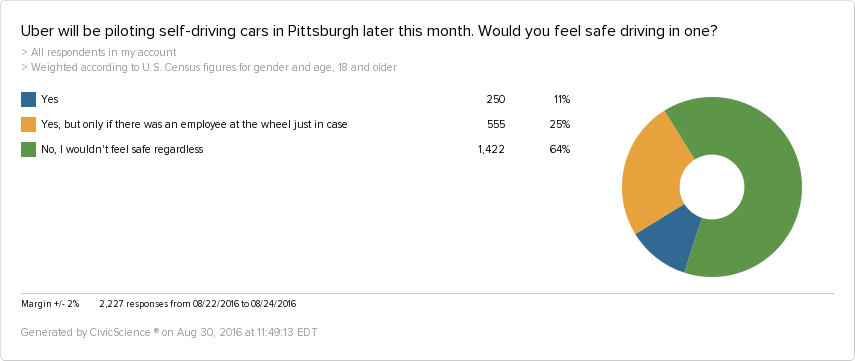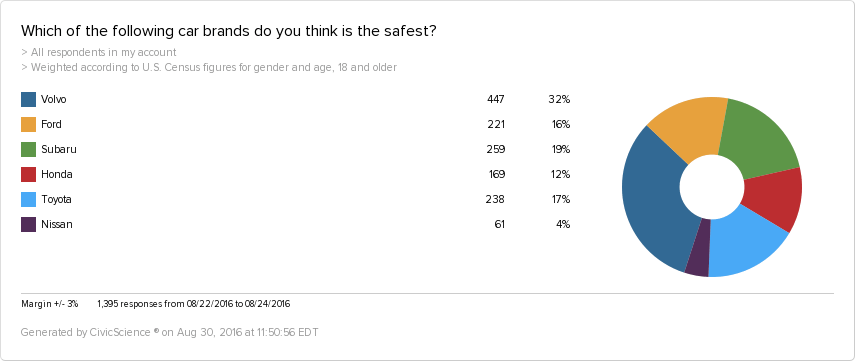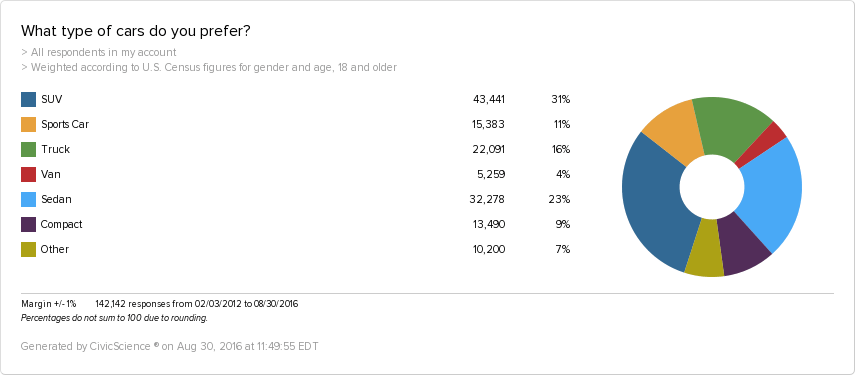I’m not sure what religious figures I believe in, but whoever they are, I think I saw them yesterday on the corner of Baum Boulevard and Cypress Avenue…. In a car. Scratch that, as a car.
It was a self-driving Uber – one of 100 that will be in Pittsburgh by tomorrow. The only way to describe it is a car on steroids, or a reincarnated religious figure (there may be other ways but I’m sticking to this). I jumped into a standard Uber seconds after and the driver, ironically, complained about the safety hazards of the new cars as he drove through a stop sign. Super-Uber: 1, Human: 0. Since when did 2016 become 2060?
Amidst all the hype surrounding these new cars, we’ve heard about everything from their insane laser and GPS capabilities to Uber’s business and investment decisions, but what we haven’t heard much of is what the public thinks. So, we asked this simple but seemingly overlooked question.
As you can see, only 36% of the people we asked say they are at all likely to feel safe in a self-driving Uber, the majority of whom would only feel safe if there was an employee at the wheel. Luckily for them, experts say we are a long way away from fully autonomous vehicles, so each self-driving Uber will have a trained engineer at the wheel.
The Fearless and the Fearful
We found that 59% of those who would feel safe in self-driving Ubers are men, mostly between the ages of 35 and 44. Also, 46% of them have a Bachelor’s or Associate Degree, a bit higher than the national average. Maybe these College grads feel more comfortable with the new technology because they have had exposure to similar technology in college classrooms. In addition, there are a slightly higher number of people with Grad or Professional Degrees in this group.
Those who wouldn’t feel safe are almost equally split between men and women, and are generally 45 and older. What this says is that the older population may not be as receptive to this new technology as younger people. This age bracket is also less likely to use Uber in the first place, but their discomfort with this move may alienate them further.
Lastly, we found that parents and grandparents are less likely to feel safe in a self-driving car. Perhaps their hesitance lies with the safety of their children, as many ride with their children in Ubers, or even use them to shuttle their kids to and from home. Are there safety features, such as extra airbags, that these cars have? If a child gets lost in an Uber, who do they ask for help if not the driver? These are questions Uber will have to grapple with in order to win over these potentially worried parents.
With all of these hesitations and uncertainties, how can Uber overcome them? The short answer – they’re smart.
Something New, Something Borrowed
It is most likely no coincidence that Uber is using Volvo SUVs as their first self-driving cars. Though these aren’t seen as the best cars, they are consistently viewed as the safest – a critical perception when beginning this bold trial.
In the 2014 Car-Brand Perception Survey, among other years as well, you will only see Volvo listed once or twice. You will not see it rated at the top, or even at all, among quality, design, performance, or even value. However, year after year, it is notably ranked first place for safety – the second most important factor for consumers when buying a new car – and it is a factor that is only increasing in importance. After all, car-related deaths in the U.S. increased 7% from 2014 to 2015. That is the largest single-year rise since 1966. So, to confirm the survey findings and dig deeper, we asked our own question comparing Volvos to more common Uber car brands.
As you can see, we arrived at near-identical results as the reports. Volvo far outweighs the other popular Uber car brands in terms of perception of safety – but that’s not all.
The majority of those we polled prefer SUVs, as shown. Maybe this is because they are more spacious, maybe because they are more safe. The important part is the perception, and that Uber has picked the brand that the most people feel is safest, and the size that most people think is best. The combination of these two might just help entice those who aren’t yet ready to take the leap into the future. In fact, 38% of those who say they would not feel safe in these Ubers prefer SUVs.
Though other companies are testing similar technology, such as nuTonomy in Singapore, it seems Uber is one of few that has considered the perception and feel of the cars as well. The technology is no good if people are unwilling to try it.
So even though Uber may be moving faster than the comfort of its clients, it has put in place measures to instill a sense of safety and comfort amidst the uncomfortable. This strategy may be important for other innovative companies to understand as well, if it succeeds. When trying to move others to transition from old to new, it may be useful to keep something trusted, something that people already know, to help them to take the leap.











